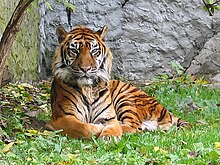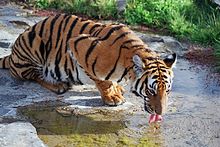Subspecies
-
There are nine recent subspecies of tiger, three of which are extinct. Their historical range (severely diminished today) ran through Bangladesh, Siberia,Iran, Afghanistan, India, China, and southeast Asia, including some Indonesian islands. The surviving subspecies, in descending order of wild population, are:
The Bengal tiger or the Royal Bengal tiger (Panthera tigris tigris) is the most common subspecies of tiger and is found primarily in India andBangladesh.[33] It lives in varied habitats: grasslands, subtropical and tropical rainforests, scrub forests, wet and dry deciduous forests, and mangroves. Males in the wild usually weigh 205 to 227 kg (450 to 500 lb), while the average female will weigh about 141 kg.[34] However, the northern Indian and the Nepalese Bengal tigers are somewhat bulkier than those found in the south of the Indian Subcontinent, with males averaging around 235 kilograms (520 lb).[34] While conservationists already believed the population
- The Indochinese Tiger (Panthera tigris corbetti), also called Corbett'stiger, is found in Cambodia, China, Laos, Burma, Thailand, and Vietnam. These tigers are smaller and darker than Bengal tigers: Males weigh from 150–190 kg (330–420 lb) while females are smaller at 110–140 kg (240–310 lb). Their preferred habitat is forests in mountainous or hilly regions. Estimates of the Indochinese tiger population vary between 1,200 to 1,800, with only
several hundred left in the wild. All existing populations are at extreme risk from poaching, prey depletion as a result of poaching of primary prey species such as deer and wild pigs, habitat fragmentation andinbreeding. In Vietnam, almost three-quarters of the tigers killed provide stock for Chinese pharmacies.
- The Sumatran Tiger (Panthera tigris sumatrae) is found only on the Indonesian island of Sumatra, and iscritically endangered.[41] It is the smallest of all living tiger subspecies, with adult males weighing between 100–140 kg (220–310 lb) and females 75–110 kg (170–240 lb).[42] Their small size is an adaptation to the thick, dense forests of the island of Sumatra where they reside, as well as the smaller-sized prey. The wild population is estimated at between 400 and 500, seen chiefly in the island's national parks. Recent genetic testing has revealed the presence of unique genetic markers, indicating that it may develop into a separate species,[specify] if it does not go extinct.[43] This has led to suggestions that Sumatran tigers should have greater priority for conservation than any other subspecies. While habitat destruction is the main threat to existin
g tiger population (logging continues even in the supposedly protected national parks), 66 tigers were recorded as being shot and killed between 1998 and 2000, or nearly 20% of the total population.
The Siberian tiger (Panthera tigris altaica), also known as the Amur,Manchurian, Altaic, Korean or North China tiger, which is the most northernmost subspecies, is confined to the Amur-Ussuri region ofPrimorsky Krai and Khabarovsk Krai in far eastern Siberia, where it is now protected.[44] The largest
- subspecies of tiger, it has a head and body length of 160–180 cm (63–71 in) for females and 190–230+ cm (75–91 in) for males, plus a tail of about 60–110 cm long (about 270–330 cm in total length) and an average weight of around 227 kilograms (500 lb) for males,[34] the Amur tiger is also noted for its thick coat, distinguished by a paler golden hue and fewer stripes. The heaviest wild Siberian tiger on record weighed in at 384 kilograms (850 lb),[45] but according to Mazak these giants are not confirmed via reliable references.[24] Even so, a six-month old Siberian tiger can be as big as a fully grown leopard. The last two censuses (1996 and 2005) found 450–500 Amur tigers within their single, and more or less continuous, range making it one of the largest undivided tiger populations in the world. Genetic research in 2009 demonstrated that the Siberian tiger, and the western "Caspian tiger" (once thought to have been a separate subspecies that became extinct in the wild in the late 1950s[46][47]) are actually the same subspecies, since the separation of the two populations may have occurred as recently as the past century due to human intervention.[48]
- The South China tiger (Panthera tigris amoyensis), also known as theAmoy or Xiamen tiger, is the most critically endangered subspecies of tiger and is listed as one of the 10 most endangered animals in the world.[49][clarification needed] One of the smaller tiger subspecies, the length of the South China tiger ranges from 2.2–2.6 m (87–100 in) for both males and females. Males weigh between 127 and 177 kg (280 and 390 lb) while females weigh between 100 and 118 kg (220 and 260 lb). From 1983 to 2007, no South China tigers were sighted.[50] In 2007 a farmer spotted a tiger and handed in photographs to the authorities as proof.[50][51] The photographs in question, however, were later exposed as fake, copied from a Chinese calendar and digitally altered, and the “sighting” turned into a massive scandal.[52][53][54]
In 1977, the Chinese government passed a law banning the killing of wild tigers, but this may have been too late to save the subspecies, since it is possibly already extinct in the wild. There are currently 59 known captive South China tigers, all within China, but these are known to be descended from only six animals. Thus, the genetic diversity required to maintain the subspecies may no longer exist. Currently, there are breeding efforts to reintroduce these tigers to the wild.







No comments:
Post a Comment